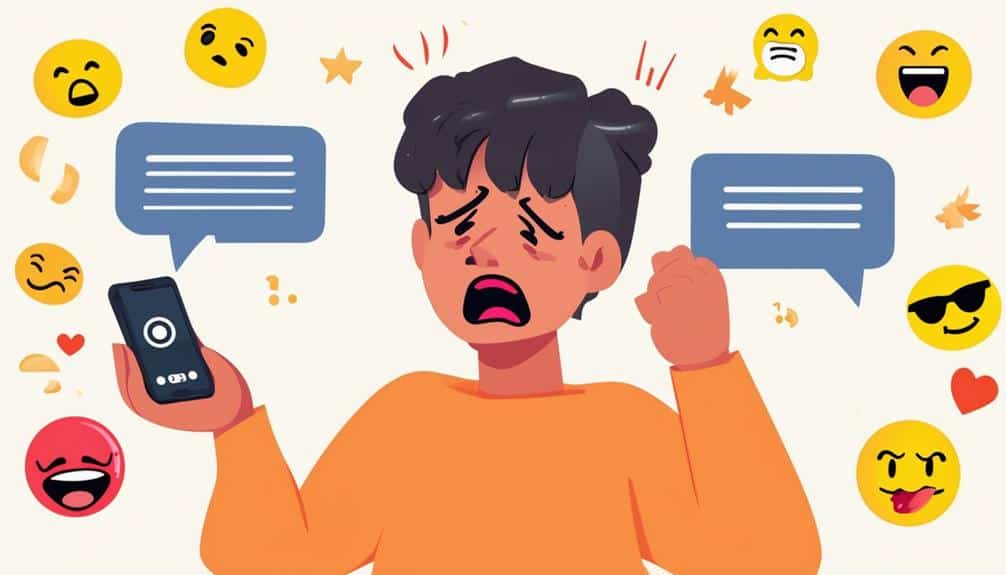In today’s world of instant communication, voicemail frustration is a common issue. Business owners often believe letting their ringing phone go to voicemail is a good strategy. However, the reality is quite different. Customers who encounter voicemails instead of actual interaction with the business feel ignored and annoyed. This voicemail frustration can lead to missed opportunities and a negative perception of your business.
Many people find voicemails to be intrusive and frustrating. Long, automated instructions and rambling greetings only add to the annoyance. The dread of checking voicemails and the cognitive fatigue it causes can significantly impact concentration and productivity. By understanding these frustrations, business owners can explore more efficient communication methods to enhance customer satisfaction and improve overall workflow.
Top 5 Reasons People Dislike Voicemail LaunchedKey Takeaways
- People often feel frustrated and disrupted by voicemails due to their intrusive nature and the cognitive fatigue they cause.
- Long automated instructions and rambling voicemail greetings create annoyance and a negative perception.
- The mystery surrounding voicemails and the potential for scams or robocalls can create uncertainty and hesitation.
- The task of checking and responding to voicemails can trigger dread, anxiety, and a sense of guilt for not answering immediately.
Understanding Voicemail Annoyances

Exploring the various annoyances associated with voicemail is essential to comprehending many people’s aversion to this communication method. One of the primary irritants is the long-winded instructions from robotic voicemail systems. Often seen as impersonal and time-consuming, these systems can lead to frustration, particularly when compared to the immediacy and brevity of other communication methods, such as text messages or phone calls.
Another source of frustration is the tendency of some people to leave rambling, lengthy, outgoing greetings. This can exacerbate the dread many feel when checking voicemail, a task already fraught with the anticipation of messages that demand something or bring complaints. The impact voicemail further compounds this dread can have on concentration. Phone interruptions disrupt focus, and the motivation to listen to messages often dwindles in the face of more pressing tasks or preferred communication methods.
The preference for short, immediate communication methods, such as email or text messages over voicemail, is clear. The annoyances associated with voicemail have driven many to seek alternative methods of communication, emphasizing the importance of understanding these frustrations and their implications.
Deciphering Types of Voicemail Calls

While the annoyances and inconveniences linked with voicemail are noteworthy, the varieties of voicemail calls and their content also play a substantial role in shaping people’s perceptions and feelings towards this form of communication. Voicemail calls can range from unavailable, private, or blocked numbers, with many going straight to voicemail. These types of calls often carry a sense of mystery and uncertainty that can induce anxiety for the recipient.
For instance, iPhones display caller information along with the voicemail message length, allowing individuals a semblance of control over answering their calls. However, this feature can also contribute to the dread associated with voicemail. If a message is too lengthy or from an unfamiliar number, people may feel overwhelmed or apprehensive about the content.
Furthermore, most voicemail messages are requests or complaints, adding to the negative perception of voicemail. These messages often require the recipient’s time and effort, making voicemail seem like a burden rather than a convenience. The varieties of voicemail calls received, thus, influence the overall annoyance and dread associated with checking and responding to voicemail messages.
Voicemail’s Impact on Concentration

Despite its intended convenience, voicemail often serves as disruption, shattering focus and hindering productivity due to its intrusive nature. Its impact on concentration cannot be overlooked. With every beep indicating a new voicemail, there is a potential interruption and a fragment of time lost, which can significantly compromise the quality of work produced.
Voicemail’s interference with concentration can be visualized through the following points:
- The sudden intrusion of a voicemail notification disrupts the workflow, causing a break in concentration.
- The mental effort required to switch focus from the task at hand to attend to a voicemail is considerable, often leading to cognitive fatigue.
- The guilt associated with ignoring voicemails can lead to anxiety, further distracting from the task at hand.
Personal Insights on Voicemail

Shifting our focus to individual insights on voicemail, it is evident that many people perceive this form of communication as disruptive and burdensome. The struggles to balance managing voicemails and work demands further exacerbate this perception. Through this lens, we will critically examine the factors that contribute to the reluctance to promptly respond to voicemails and strategies that can be implemented to manage this effectively.
Voicemail: A Disruptive Nuisance?
In the domain of private insights, voicemail often emerges as a disruptive nuisance that hampers focus and concentration. It triggers a sense of dread mainly linked to the nature of the messages received, which primarily consist of requests or complaints. A prevailing preference for immediate, concise communication methods like email heightens anxiety.
Personal expendables paint a vivid picture:
- The anticipation of pressing ‘play’ and not knowing what to expect, ranging from a benign update to an urgent request.
- The exasperation of listening to a long-winded message when a simple text could have sufficed.
- There is a constant tug-of-war between the need to stay updated and the desire to maintain peace of mind.
Some folks have modified their voicemail prompts to reclaim their time and mental space, encouraging text messages over voicemails. This trend underscores the struggle many face with voicemails – the balance between accessibility and tranquility. While voicemails aim to bridge communication gaps, they inadvertently create new ones.
Struggling With Voicemail Balance
Many, like Andy Tarnoff, find themselves juggling the demands of work responsibilities and the need for a tranquil environment when sailing the stormy waters of voicemail management. In his candid admission, Tarnoff elucidates the problem of voicemail struggles, often delaying responses due to work-induced exhaustion. His honest, outgoing message, promising to return calls promptly, reflects an underlying challenge of gathering the motivation to handle voicemails quickly.
Tarnoff’s approach to voicemail management is remarkable. He discourages the leaving of messages by modifying his greeting, subtly indicating a preference for quiet. Urgent messages are requested to be sent via text, enhancing efficiency and offering an additional layer of security. Although seemingly minor, such modifications profoundly shape the balance between work responsibilities and peacefulness.
Tarnoff’s positive feedback from business contacts affirms the impact of addressing voicemail struggles directly. It demonstrates the possibility of finding equilibrium in the chaotic landscape of voicemail management, providing a sense of belonging for those wrestling with similar issues. Hence, the struggle with voicemail balance is not just a single person’s plight but a shared experience in the modern world of communication.
Sending Calls to Voicemail: Challenges

Sending calls to voicemail presents significant challenges for individuals, often time-consuming and energy-draining. Modern societal norms, the high prevalence of unanswered calls, and even the quality of customer service contribute to this issue.
The challenges involved with sending calls to voicemail include:
- Hesitation due to the high frequency of scams and robocalls leads to unease about answering any call.
- There is a general discomfort with talking on the phone, which often leads to unanswered calls, especially for those who prefer text-based communication.
- Listening to and responding to voicemails takes time and energy, which can be particularly draining for people who receive a high volume of calls.
This poses significant hurdles for individuals and organizations alike. As societal norms and communication preferences evolve, the complexity of managing phone calls and voicemails will likely increase. This underlines the need for user-friendly, efficient solutions for unanswered calls and voicemail management.
Robocall Prevention and Awareness

The proliferation of robocalls presents distinct challenges, both for regulatory bodies and individual recipients. Solutions, including call-blocking apps, technological advancements like STIR/SHAKEN, and regulatory enforcement, are being explored and implemented. Meanwhile, private strategies, including awareness and education campaigns, are essential for individual protection, necessitating thorough understanding and vigilant response to this ubiquitous issue.
Combating Robocall Menace
Inundated by the relentless surge of robocalls, the Federal Trade Commission (FTC) grapples with formulating an effective, long-term solution, highlighting the importance of self-awareness and proactive measures in mitigating this threat. The issue has become so widespread that it often disrupts the flow of authentic communication, leaving a voicemail or a missed phone call under suspicion. Consequently, this fosters a sense of mistrust, which could impede human connections’ natural progression.
The FTC’s struggle against this challenge encompasses several aspects, including:
- They are empowered to distinguish between a legitimate phone call and a robocall.
- I am advocating for strict laws to penalize robocall perpetrators.
- We are collaborating with telecommunication service providers to implement advanced call-filtering options.
Furthermore, the FTC continually develops robust technological solutions to identify and block intrusive calls. This multifaceted approach aims to restore phone users’ sense of security and belonging, reinstate voicemails’ credibility, and ensure communication’s sanctity.
Individual Protection Strategies
Despite the FTC’s relentless efforts, protection strategies are essential in the fight against robocalls, with awareness and proactive measures being key elements. Text messaging has become a standard method for scammers to reach potential victims, and consequently, individuals must be educated on the prevalence and tactics of these fraudulent calls.
One effective strategy that people can employ is to utilize call-blocking apps. These tools can add an extra layer of defense, helping to filter out known scam numbers and preventing them from reaching your phone. However, these apps are not foolproof, and it is still possible for robocalls to slip through. That’s where awareness plays a vital role.
Recognizing the signs of a scam call, such as the caller asking for sensitive or financial information, can help people quickly identify and avoid falling victim to these robocalls. Moreover, being cautious about who you give your number and not hesitating to answer the phone can go a long way in protecting oneself. As the FTC continues its fight against robocalls, it is evident that protection strategies and awareness are essential in this battle.
The Importance of Answering Calls

With every ring of the phone, there lies an opportunity for valuable connections and prospective clients, emphasizing the vital need for promptly answering calls in any business setting. Especially for a small business, every missed call might mean a lost potential customer, a thwarted partnership, or a missed chance to solve a client’s problem. When clients can’t reach the business and are forced to leave a message, they might feel unappreciated, harming the company’s reputation.
To underline the importance of answering calls, consider the following key points:
- Each call may shape your company’s future, so none should be dismissed as an inconvenience.
- Promptly answering calls can demonstrate professionalism and attentiveness.
- Engaging with callers allows you to understand your customers’ needs better.
Answering calls isn’t just a courtesy; it’s essential to running a successful business. It signifies a commitment to excellent customer service, solidifying the bond with existing clients while attracting new ones and fostering a sense of belonging that is crucial in today’s competitive market.
Gaining Insights Through Phone Calls

Harnessing the potential of phone calls can yield valuable insights into customer needs and preferences, serving as an essential tool for improving services. We can understand why people call your business through direct feedback and how this knowledge can enhance services. Every call presents an opportunity for valuable connections or potential customers.
Interestingly, some individuals prefer using the phone only as a last resort for communication, indicating a gap in the current service or product offering that requires immediate attention. Calls can offer essential insights that may not be conveyed through other channels, providing a distinct perspective that can drive customer-focused initiatives.
Consider the following table of insights garnered from phone calls:
| Insight | Significance |
|---|---|
| Direct feedback | Enables immediate service improvement |
| Customer needs | Helps customize services to meet customer demands |
| Customer preferences | Guides the development of new offerings |
| Reasons for calling | Reveals gaps in current service or product offering |
| Phone as a last resort | Indicates potential areas of enhancement |
In essence, phone calls are more than just a medium of communication; they are a rich source of insights that can significantly enhance customer experience and satisfaction.
The Role of Ruby Virtual Receptionists

Over 13,000 businesses rely on Ruby Virtual Receptionists, proving their crucial role in providing tailored attention to callers. They ensure a warm and professional greeting that serves as a seamless extension of the brand. Using caller ID, they efficiently manage each call, identifying the caller and delivering customized service.
Ruby Virtual Receptionists create an environment that fosters a sense of belonging for callers. They provide essential support in managing communication by handling every call with care, connecting businesses and customers, and making clients feel valued.
- Personalized Attention: Each call is handled with unique consideration, making customers feel important.
- Brand Extension: Ruby Virtual Receptionists serve as an extension of your brand, creating a seamless experience for the caller.
- Efficient Call Management: With caller ID, calls are managed efficiently, ensuring smooth communication.
Preference for Text-Based Communication

The evolution of communication preferences, notably among individuals under 65, has seen a significant shift towards text-based methods such as email texts, as indicated by a Sprint survey that revealed quicker responses to these mediums than voicemails. This preference for text-based communication is not just about the speed of response—email convenience, clarity, and efficiency are crucial for effective communication in today’s fast-paced world.
| Communication Method | Preference Reasons |
|---|---|
| EmaiEmailsts | Quicker response, Provides a record of correspondence, Conveys information swiftly, Clarity and Efficiency. |
| Voicemails | Perceived as inconvenient, Slower response, Lack of clarity, Inefficient |
Visual voice emails and emails convert spoken messages into text and are gaining traction as they align with the preference for text-based communication. It combines the immediacy of voicemails with the clarity and convenience of text.
This shift towards text-based communication methods indicates how people adapt to the digital age. They embrace technologies that deliver information swiftly, clearly, and efficiently, fostering a sense of belonging in a rapidly evolving world.
Efficient Communication Methods

In this rapidly evolving digital age, the efficiency oftext-based communication methods, as favored by many, especially those under 65, merits a closer examination. It’s essential to understand why text messaging and email, for example, have become the preferred modes of communication over voicemails.
Several key factors contribute to the popularity of text-based communication:
- Speed of Response: A Sprint survey highlighted that text responses are much quicker than email voicemails.
- Convenience: Text messaging allows for quick information exchanges, making it a go-to choice for busy individuals.
- Record Keeping: EmaiEmails texts provide a clear, written record of correspondence, which can be referred back to when needed.
Visual voicemail, although not strictly a text-based communication method, is another way to manage messages efficiently. It transcribes voicemails in e-mail, emailing the best aspects of both communication styles. In a world that values efficiency and ease, text-based communication methods, including text messaging, quickly overshadow traditional voicemails.
Dealing With Voicemail Challenges

Exploring the maze of voicemail challenges, many people struggle with complex instructions, long-winded greetings, and the looming dread of checking messages. This dread is often amplified by the knowledge that voicemails usually consist of requests or complaints, which can disrupt concentration and foster feelings of guilt for not responding promptly.
Consequently, many individuals prefer the immediacy of email, which offers a shorter, more direct form of communication. This preference highlights a key challenge in voicemail: finding the motivation to listen to messages, especially when overloaded with other work responsibilities.
Some people modify their outgoing messages to promise mail responses to mitigate these challenges, thus managing expectations and reducing guilt. Others delay checking voicemails until they can do so in quiet environments, which can alleviate the stress associated with this task.
Ultimately, the challenges of voicemail highlight a broader issue in our digital society: the constant quest for efficient, effective communication. As our world evolves, we must refine our communication strategies, incorporating the best aspects of voicemail and email to foster a sense of belonging and connection.
The Art of Voicemail Management

The Art of Voicemail Management is an essential skill in the digital age. It involves understanding the nuances of managing an influx of diverse messages, developing strategies for prompt response, and recognizing the potential for alternative communication methods. As we explore this subtopic, we will assess the everyday annoyances associated with voicemail and the efficient alternatives emerging in today’s fast-paced communication landscape.
Voicemail Annoyances
Exploring the realm of voicemail poses many challenges, from navigating lengthy robotic directions and friends’ verbose outgoing messages to the constant disruptions that break concentration and, in turn, foster feelings of guilt for overlooking messages and apprehension of appearing unresponsive. The fear of checking voicemail, a familiar feeling, is often rooted in the expectation of messages that require something or convey dissatisfaction.
In contrast, concise, immediate communication methods such as email are favored due to convenience and time-effectiveness. Voicemail interruptions, often seen as intrusive, can significantly impede productivity and focus. Additionally, the resulting guilt from disregarding voicemails and the apprehension of being perceived as unresponsive can generate unnecessary stress.
- Lengthy directions from automated systems
- Rambling outgoing email messages
- The disruptive nature of voicemail interruptions
Balancing the management of voicemail and work duties can be challenging, affecting individual drive and elevating the risk of burnout. As we dive deeper into voicemail, it becomes evident why many consider it more of an obstacle than an aid. Recognizing these frustrations can pave the way for more effective communication alternatives.
Efficient Alternatives
In light of these frustrations associated with traditional voicemail, several efficient alternatives have emerged, reshaping the communication landscape and offering a more streamlined approach to managing messages. Text messages and e-mails are the favored communication mediums due to their time-efficient nature. A Sprint survey substantiated this preference, revealing that text messages often elicit faster responses than voicemails. This shift indicates a growing demand for quicker, more efficient means of communication.
Visual voicemail also presents a compelling alternative, enabling users to view and prioritize messages at a glance. This application addresses message management, saving valuable time and effort. However, text-based communication appeals most to individuals under 65 due to its clarity and speed. Text messages and e-mails convey information swiftly and provide a record of correspondence. This feature enhances their utility as practical communication tools, making them the preferred choice over traditional voicemail. Thus, the evolution towards efficient alternatives underscores the need for swift, clear, and accessible means of communication in the digital age.
Frequently Asked Questions
What can businesses do to minimize voicemail frustration?
Businesses can minimize voicemail frustration by promptly answering calls and implementing efficient call-handling systems. Automated responses and follow-up messages can also help keep customers satisfied and informed.
Is It Unprofessional to Not Have a Voicemail Message?
Yes, it is generally unprofessional not to have an individualized voicemail message. A well-crafted personalized voicemail message can enhance professional credibility, increase customer satisfaction, and potentially mitigate business loss due to missed communications.
Why Don’t People Leave Voicemail Anymore?
People’s reluctance to leave voicemails can be attributed to their preference for quicker, more efficient forms of communication like texting or instant messaging and the perceived intrusiveness and anxiety associated with voicemail.
What Are Two Disadvantages of Voice Mail?
Two main disadvantages of voicemail are its intrusive nature and inefficiency. It disrupts focus, creating a ‘broken record’ effect on productivity. Moreover, its long-winded nature compared to modern communication methods can be a time-consuming inconvenience.
Is Leaving a Voicemail Rude?
Leaving a voicemail is generally not considered impolite. It’s a way to convey critical information when the recipient cannot answer. However, the message should be brief, pertinent, and mindful of the recipient’s time.
Conclusion

Erik Remmel is a co-founder of Launched, a platform that helps businesses grow through AI-powered marketing, automation, and lead generation. He focuses on building scalable systems that convert cold leads into customers while streamlining operations with smart, AI-driven workflows.

